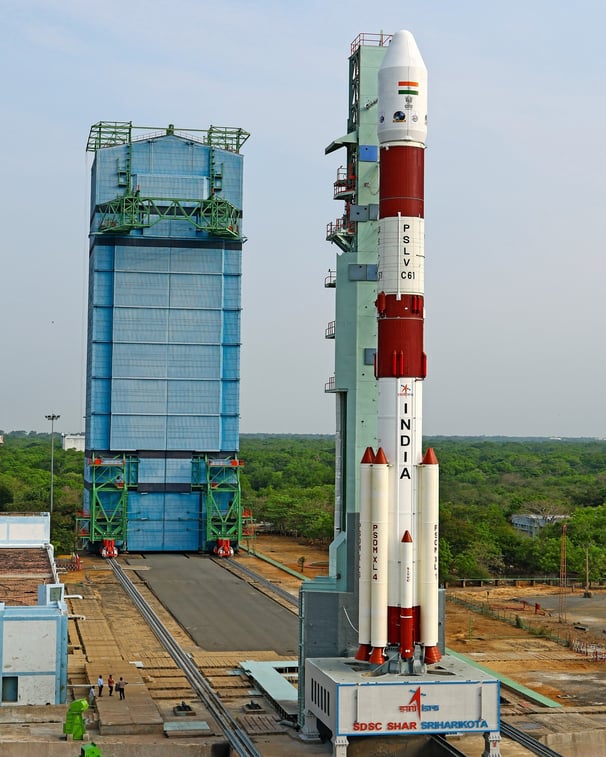PSLV-C61: A Setback Amid ISRO’s Stellar Legacy
TECHNOLOGY


On May 18, 2025, the Indian Space Research Organisation (ISRO) launched its 101st mission, the PSLV-C61, from the Satish Dhawan Space Centre in Sriharikota. This mission, the 63rd flight of the Polar Satellite Launch Vehicle (PSLV) and the 27th in its XL configuration, aimed to place the EOS-09 (RISAT-1B) satellite into a Sun-Synchronous Polar Orbit (SSPO). While the mission ended in failure due to a third-stage anomaly, ISRO’s storied history of achievements continues to shine, showcasing India’s prowess in space exploration. Let’s dive into the details of PSLV-C61 and celebrate ISRO’s remarkable journey so far.
PSLV-C61: What Happened?
The PSLV-C61 mission was poised to bolster India’s Earth observation capabilities with the EOS-09 satellite, a 1,696.24 kg C-band synthetic aperture radar satellite designed for high-resolution, all-weather imaging. Launched at 5:59 AM IST, the mission targeted applications like agriculture monitoring, disaster management, and surveillance, with the satellite expected to operate for five years.
The PSLV, a four-stage rocket alternating between solid and liquid propulsion, has been a workhorse for ISRO, known for its reliability. The first and second stages of PSLV-C61 performed flawlessly, but an anomaly in the third stage—a solid motor system—caused a drop in chamber pressure, preventing the satellite from reaching its intended orbit. This marked the first PSLV failure since 2017, a rare setback for a vehicle with a near-impeccable track record.
ISRO quickly responded by forming a failure analysis committee to investigate telemetry and flight data. The agency’s transparency and proactive approach reflect its commitment to learning from setbacks and ensuring future success. While disappointing, this failure is a minor hiccup in ISRO’s illustrious history, which is filled with groundbreaking achievements.
ISRO’s Glorious Achievements
ISRO, established in 1969, has transformed India into a global space powerhouse through innovation, cost-efficiency, and ambition. Here’s a look at some of its most significant milestones:
1. Aryabhata (1975): India’s First Satellite
ISRO’s journey began with the launch of Aryabhata, India’s first satellite, on April 19, 1975, aboard a Soviet Kosmos-3M rocket. This marked India’s entry into the space age, laying the foundation for indigenous satellite development.
2. SLV-3 Success (1980): Indigenous Launch Capability
The successful launch of the Rohini satellite (RS-1) on July 18, 1980, using the Satellite Launch Vehicle (SLV-3) was a landmark achievement. It made India the sixth nation to develop its own satellite launch capability, showcasing self-reliance in space technology.
3. PSLV: The Reliable Workhorse
The PSLV, introduced in 1993, has become ISRO’s most trusted launch vehicle, with 63 missions by 2025, including PSLV-C61. Known for its versatility, it has launched satellites for India and international clients, including the record-breaking launch of 104 satellites in a single mission (PSLV-C37) in 2017. Its XL configuration, used in PSLV-C61, enhances payload capacity for complex missions.
4. Chandrayaan Missions: Lunar Exploration
Chandrayaan-1 (2008): India’s first lunar mission confirmed water molecules on the Moon’s surface, a groundbreaking discovery. It also deployed the Moon Impact Probe, making India the fourth nation to place its flag on the lunar surface.
Chandrayaan-2 (2019): Despite the Vikram lander’s crash, the orbiter continues to provide valuable data, mapping the lunar surface with unprecedented detail.
Chandrayaan-3 (2023): ISRO achieved a historic soft landing near the Moon’s south pole, making India the first nation to land in this region and the fourth to achieve a lunar soft landing. The Pragyan rover’s exploration further cemented ISRO’s lunar legacy.
5. Mangalyaan: Mars on a Budget
Launched in 2013, the Mars Orbiter Mission (Mangalyaan) made India the first Asian nation to reach Mars orbit and the first globally to succeed on its maiden attempt. Costing just $74 million, it demonstrated ISRO’s ability to deliver world-class missions at a fraction of the cost of Western counterparts.
6. Navigation and Communication Systems
IRNSS (NavIC): ISRO’s Indian Regional Navigation Satellite System provides accurate positioning services across India and 1,500 km beyond, reducing reliance on GPS.
GSAT Series: ISRO’s communication satellites have revolutionized telecommunications, broadcasting, and broadband services in India, supporting initiatives like Digital India.
7. Aditya-L1 (2024): Solar Exploration
India’s first solar mission, Aditya-L1, positioned at the L1 Lagrange point, studies the Sun’s corona, solar flares, and space weather. This mission underscores ISRO’s growing expertise in deep-space exploration.
8. Gaganyaan: Human Spaceflight Ambitions
ISRO’s Gaganyaan program aims to send Indian astronauts to low Earth orbit by 2026. Successful uncrewed tests and astronaut training in 2024 have brought India closer to becoming the fourth nation with human spaceflight capabilities.
9. Commercial Success and Global Reach
Through Antrix Corporation, ISRO has launched over 300 foreign satellites, earning significant revenue. Missions like PSLV-C37 and the commercial launches of OneWeb satellites highlight ISRO’s growing role in the global space market.
Why PSLV-C61’s Failure Doesn’t Dim ISRO’s Shine
Space exploration is inherently challenging, and setbacks are part of the journey. ISRO’s response to PSLV-C61—swift analysis and a commitment to improvement—mirrors its approach to past challenges, such as the initial PSLV failures in the 1990s. Each setback has fueled innovation, leading to successes like Chandrayaan-3 and Mangalyaan.
The PSLV’s reliability, with over 95% success rate, remains unmatched, and ISRO’s ability to deliver complex missions on modest budgets continues to inspire. The EOS-09 mission’s goals will likely be revisited in future launches, building on lessons from PSLV-C61.
Looking Ahead
ISRO’s roadmap is packed with exciting projects:
Shukrayaan-1: A Venus orbiter mission planned for 2028.
Mangalyaan-2: A second Mars mission with a rover and orbiter.
Lunar and Asteroid Missions: Plans for lunar sample return and asteroid exploration.
Reusable Launch Vehicles: ISRO is developing next-generation rockets to reduce launch costs
Conclusion
The PSLV-C61 mission, though unsuccessful, is a reminder of the risks inherent in pushing the boundaries of science. ISRO’s legacy, built on decades of innovation, resilience, and ambition, remains untarnished. From launching India’s first satellite to landing on the Moon’s south pole, ISRO has inspired a nation and the world. As it investigates PSLV-C61 and prepares for future missions, ISRO continues to aim for the stars, proving that even setbacks are stepping stones to greater heights.